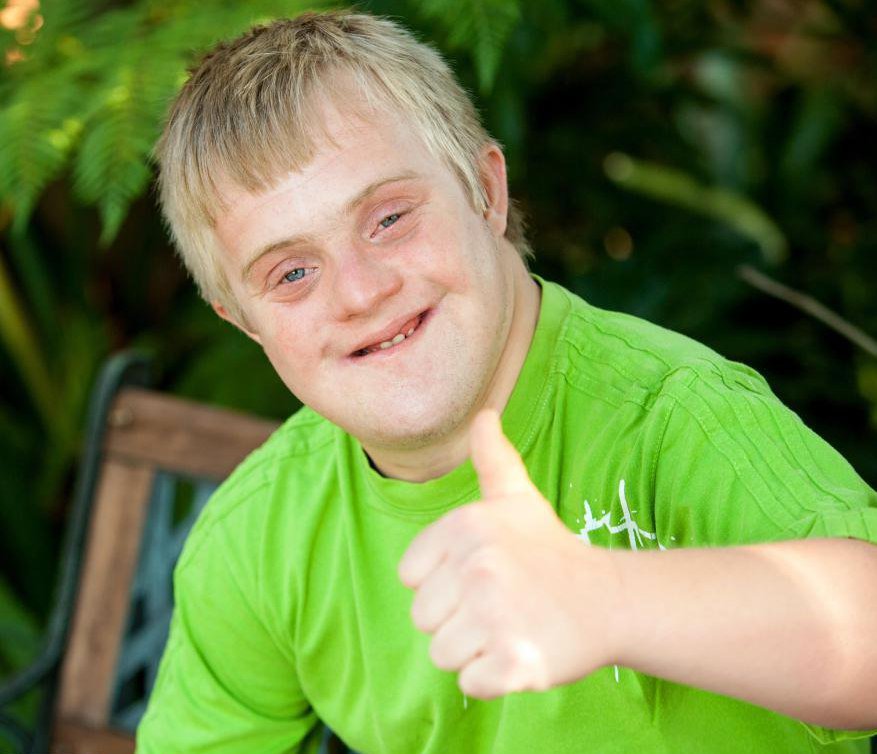
Down syndrome is the most common chromosomal abnormality. It is not a disease, disorder, defect or medical condition. Humans are made from a genetic material called genes, inherited from each parent. Genes carry hereditary information in rod-like structures called chromosomes. A cell typically contains 23 pairs of chromosomes, half contributed by each parent. When an individual has a full or partial extra copy on chromosome 21, Down syndrome occurs. The additional chromosome alters the development of the cells resulting in characteristics associated with Down syndrome. A chromosomal analysis called a karyotype is done to confirm the diagnosis. Each individual is unique and common physical traits of Down syndrome occur in different degrees. An individual living with Down syndrome may possess mild to severe cognitive delays, a congenital heart malformation, respiratory or hearing problems, thyroid conditions, low muscle tone, short stature, small ears, a larger tongue, smaller limbs, slight slant to the eyes, a slightly flattened facial profile and a single crease across the palm. It is present in about 1 in every 800 babies in Canada. (cdss.ca)
Down syndrome is universal across racial and economic levels; however, research shows that older women have an increased chance of having a child with Down syndrome. Blood tests and ultrasounds are used in the screening process to identify if an unborn child may be carrying Down syndrome genes.

In 1866, an English physician named John Langdon Down gained recognition as the “father” of the syndrome after publishing an accurate description of a person with Down syndrome. In 1959 a French physician, Jérôme Lejeune, identified that an extra partial or whole copy of chromosome 21 results in the characteristics associated with Down syndrome.

Currently, research has distinguished three types of Down Syndrome:
Trisomy 21:
caused when 21st chromosome fails to separate prior to or at conception. This extra chromosome is then replicated in each of the body cells as the embryo develops. This type accounts for 95% of Down syndrome cases. (ndss.org)
Mosaicism:
occurs when chromosome 21 fails to separate in one of the initial cell divisions after fertilization creating some cells to contain 47 chromosomes rather than the usual 46. This type accounts for 2% of Down syndrome cases. (cdss.ca)
Translocation:
occurs during cell division when part of chromosome 21 breaks off and attaches to another chromosome, typically chromosome 14. The cells contain 46 chromosomes however the extra part of chromosome 21 causes Down syndrome characteristics. This type accounts for about 3% of all cases of Down syndrome. (cdss.ca)

In the past individuals with Down syndrome were only expected to survive until age 20. Presently with advanced medical treatment, corrective heart surgery and the discovery of antibodies the life expectancy of an individual may be well past the age of 60. However, current research shows that an individual with Down syndrome may experience brain changes similar to that of Alzheimer’s disease in their forties, though not progressing into dementia. (bandofangels.com)

Behavior challenges or concerns in an individual with Down syndrome are typically no different from others in the same developmental age though frequency and intensity may be magnified. Behaviour may be their way of communicating frustration or a lack of understanding due to communication, language or processing problems.

Many individuals with Down syndrome self-talk or talk to themselves which isn’t a concern. It’s important to also consider that the behaviour being displayed may be influenced by acute or chronic medical problems are associated with the individual (e.g. vision, hearing, sleep apnea, anxiety, etc.). Some common behavioural concerns include wandering, running, oppositional behaviour, being stubborn, attention problems, obsessive/compulsive and Autism (occurring in 5-7%).
All individuals with Down syndrome experience mild to moderate cognitive delays (ndss.org) influencing their learning styles. Finding the most effective and productive method for learning and teaching can be a challenge. Early intervention, quality education, and a stimulating home environment are key in developing their full potential.

RELATED LINKS:
down-syndrome.org
thearc.org
ds-int.org
ndss.org
cdadc.com/ds/
dsao.ca/
cdss.ca
Join The Conversation
Are you supporting an individual with Down Syndrome? What is the greatest challenge you deal with as a caregiver? Leave me a comment here, and join the conversation on Facebook where I asked, “The great challenge I face supporting an individual with Down Syndrome is_____________.”
Workshop Presentation - Visual Aids and Strategies
Contact Vizually Speaking today to learn how Visual Aids and Strategies can decrease the undesired behaviour(s), improve communication, promote independence and increase self-confidence. Through our dynamic presentation you will:
✓ Uncover the importance of using Visual Aids and Strategies.
✓ Discover the benefits of Visual Aids and Strategies.
✓ Learn how to overcome communication barriers.
✓ Promote independence and decrease undesired behaviours.
✓ Be introduced to NEW resources.
EVERYONE benefits from Visual Aids!

Vizually Speaking understands that finding time in today’s high demanding world to create visual aids and strategies can be a great challenge. Vizually Speaking is committed to collaboratively work together providing a step by step support, assisting in the development and implementation of individualized visual aids and strategies for an individual with Down syndrome. For a FREE consultation contact us TODAY!




